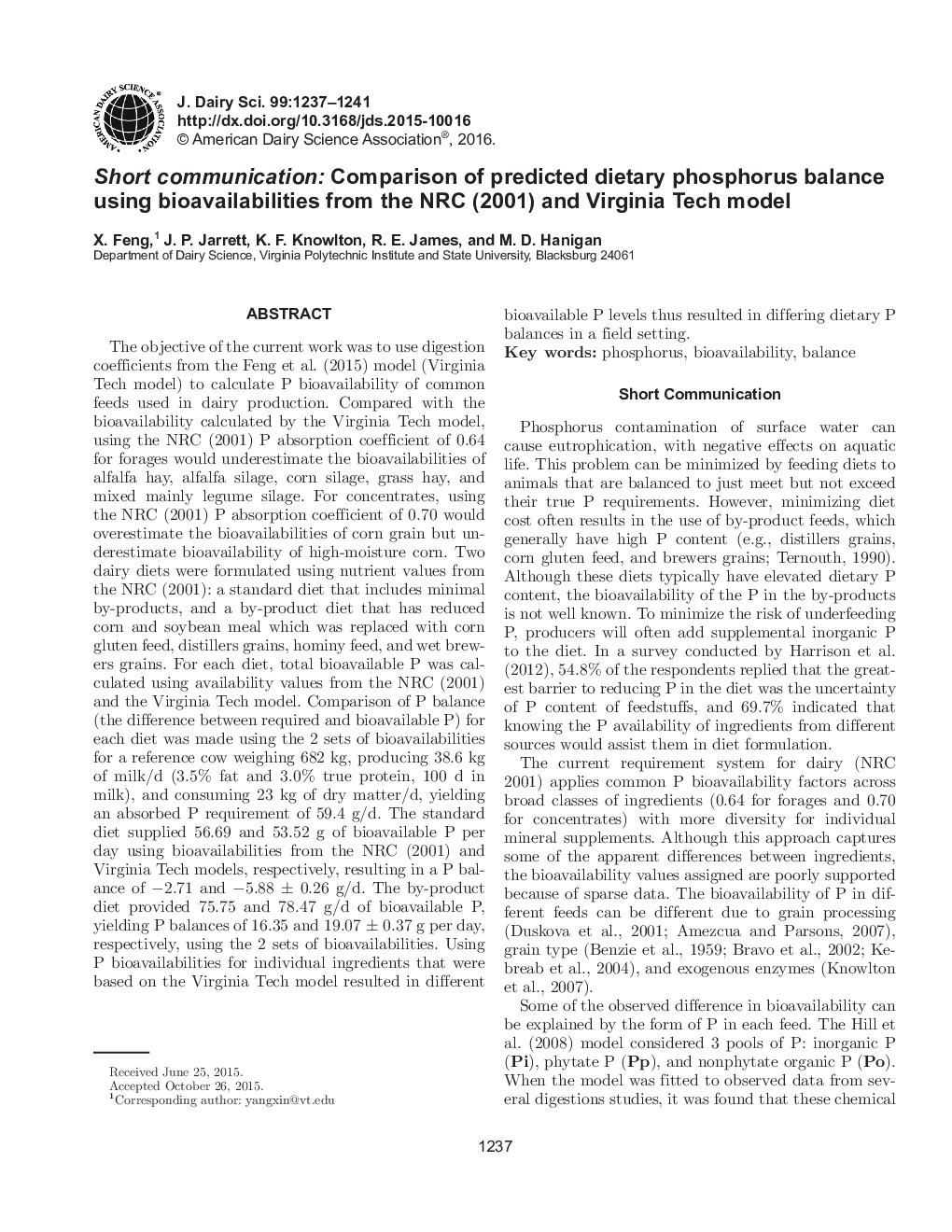| کد مقاله | کد نشریه | سال انتشار | مقاله انگلیسی | نسخه تمام متن |
|---|---|---|---|---|
| 10973555 | 1108016 | 2016 | 5 صفحه PDF | دانلود رایگان |
عنوان انگلیسی مقاله ISI
Short communication: Comparison of predicted dietary phosphorus balance using bioavailabilities from the NRC (2001) and Virginia Tech model
دانلود مقاله + سفارش ترجمه
دانلود مقاله ISI انگلیسی
رایگان برای ایرانیان
موضوعات مرتبط
علوم زیستی و بیوفناوری
علوم کشاورزی و بیولوژیک
علوم دامی و جانورشناسی
پیش نمایش صفحه اول مقاله

چکیده انگلیسی
The objective of the current work was to use digestion coefficients from the Feng et al. (2015) model (Virginia Tech model) to calculate P bioavailability of common feeds used in dairy production. Compared with the bioavailability calculated by the Virginia Tech model, using the NRC (2001) P absorption coefficient of 0.64 for forages would underestimate the bioavailabilities of alfalfa hay, alfalfa silage, corn silage, grass hay, and mixed mainly legume silage. For concentrates, using the NRC (2001) P absorption coefficient of 0.70 would overestimate the bioavailabilities of corn grain but underestimate bioavailability of high-moisture corn. Two dairy diets were formulated using nutrient values from the NRC (2001): a standard diet that includes minimal by-products, and a by-product diet that has reduced corn and soybean meal which was replaced with corn gluten feed, distillers grains, hominy feed, and wet brewers grains. For each diet, total bioavailable P was calculated using availability values from the NRC (2001) and the Virginia Tech model. Comparison of P balance (the difference between required and bioavailable P) for each diet was made using the 2 sets of bioavailabilities for a reference cow weighing 682 kg, producing 38.6 kg of milk/d (3.5% fat and 3.0% true protein, 100 d in milk), and consuming 23 kg of dry matter/d, yielding an absorbed P requirement of 59.4 g/d. The standard diet supplied 56.69 and 53.52 g of bioavailable P per day using bioavailabilities from the NRC (2001) and Virginia Tech models, respectively, resulting in a P balance of â2.71 and â5.88 ± 0.26 g/d. The by-product diet provided 75.75 and 78.47 g/d of bioavailable P, yielding P balances of 16.35 and 19.07 ± 0.37 g per day, respectively, using the 2 sets of bioavailabilities. Using P bioavailabilities for individual ingredients that were based on the Virginia Tech model resulted in different bioavailable P levels thus resulted in differing dietary P balances in a field setting.
ناشر
Database: Elsevier - ScienceDirect (ساینس دایرکت)
Journal: Journal of Dairy Science - Volume 99, Issue 2, February 2016, Pages 1237-1241
Journal: Journal of Dairy Science - Volume 99, Issue 2, February 2016, Pages 1237-1241
نویسندگان
X. Feng, J.P. Jarrett, K.F. Knowlton, R.E. James, M.D. Hanigan,